2018 年广东财经大学英语水平考试考研真题
考试年度:2018 年
适用专业:050201 英语语言文学
[友情提醒:请在考点提供的专用答题纸上答题,答在本卷或草稿纸上无效!]
考试科目代码及名称:613-英语水平考试(自命题)
一、 Cloze 完形填空(30 题,每题 1 分,共 30 分)
Passage One
Dear Miss Brown,
Thank you for your letter of 5 October, concerning faulty goods purchased in our
store in Basingstoke.
I am very sorry indeed that you were not satisfied with the celebration chocolates
that you bought from our store. I can 1 ┄┄ your disappointment when you discovered
that the chocolates were not as shown on the 2 ┄┄and were, in 3 ┄┄, all the same
shape.
Our company is always trying to improve the 4 ┄┄of its merchandise, and we are
very unhappy when one of our products does not 5 ┄┄satisfaction.
The manufacturers of our chocolates have 6 ┄┄guidelines for production, which
should 7 ┄┄instances such as this from happening. Obviously our checking and
packing procedures were not 8 ┄┄, and we will discuss this with the manufacturers.
In the 9 ┄┄, I regret the disappointment you were 10 ┄┄. As a gesture of goodwill,
I have pleasure in refunding the 11 ┄┄of the chocolates, and enclose a gift voucher
that you can 12 ┄┄in our Basingstoke branch.
Thank you for bringing this matter to our 13 ┄┄. I hope any future purchases you
may 14 ┄┄at our stores will be up to our 15 ┄┄high standards.
Yours sincerely,
A N Ferguson
A N Ferguson
Customer Relations
1.
2.
3.
4.
5.
6.
7.
8.
9.
10
A.
A.
A.
A.
A.
A.
A.
A.
A.
A.
know
packaging
point
worth
meet
straight
prevent
followed
while
brought
B.
B.
B.
B.
B.
B.
B.
B.
B.
B.
distinguish
layer
fact
goodness
supply
pure
avoid
admitted
meantime
caused
C.
C.
C.
C.
C.
C.
C.
C.
C.
C.
understand
parcel
honesty
quality
present
immediate
forbid
confirmed
period
effected
D.
D.
D.
D.
D.
D.
D.
D.
D.
D.
recognise
envelope
detail
grade
give
clear
contain
engaged
space
produced
�
.
11
.
12
.
13
.
14
.
15
.
A.
cost
B.
money
C.
amount
D.
bill
A.
employ
B.
operate
C.
apply
D.
use
A.
view
B.
attention
C.
sight
D.
regard
A.
move
B.
have
C.
make
D.
do
A.
ordinary
B.
usual
C.
common
D.
natural
Passage Two
During the last year, we announced the significant expansion of our plastic
sheeting plant in Malaysia, which, together with the acquisition of the Indonesian
factory, will approximately double the Group’s manufacturing 16…. The cost of this
development is within 17… and will be approximately $5.6m, of which $2.7m was
incurred during the previous year. It is on schedule to 18…… increasing volumes
from October this year. Following the 19…… of plastic tubing manufacture from
Germany to Thailand, we have effectively doubled the capacity of this facility at
an 20…………
cost of $12m. The project is set to cost less than the original 21……… and is on
target for increased production by June next year. In February, we announced our
22……… to sell our factory in Ireland. This decision is in line with the Group’
s strategy of 23…… on our core categories of branded products. In June, we
announced investment in a new state-of-the-art UK manufacturing facility for
specialist plastic components. This facility will be 24……by the middle of next
year and will increase the Group’s capacity to manufacture products efficiently
in-house. At the same time it will 25… about 200 new jobs in an area of high
unemployment. The factory is to cost approximately $24m, towards which government
26…of up to $4m are already available. Sadly, as part of this move, we announced
the 27… of our Blackburn facility, which is due to take place in the early part
of next year.
As part of our commitment to effective external communications with all our
stakeholders, in October we 28… the corporate website, which is now providing
up-to-date information on the Group, and we look forward to receiving 29…from users
of the site. Existing product websites are now in the 30…of being redesigned as
part of the global rebranding strategy.
B
yield
B income
C total
C account
D mass
D fund
B transfer
C advance D deliver
A output
A budget
A forward
A replacement
16
17
18
19
20.
B rearranging C relocation
D redistribution
A aimed
B imagined C accepted D expected
�
A guess
B judgment C estimate D conviction
B object
C intention
D purpose
21.
22
23
24
25
26
27
28
29
30
A focus
A concentrating
A running
A appoint
A scholarships
A finish
A dispatched
A attitude
A practice
B planning
C attending
D directing
B implementing
B result
C employ
B grants
C executing
D organizing
D create
C allocations
D gifts
B closure
C ending
D conclusion
B prompted C launched D effected
B approach
B progress
C outlook
C process
D feedback
D procedure
二、 Proofreading and error correction 改错题 (15 题,每题 2 分,共 30 分)
1. Market research involves in collecting and sorting facts and opinions from
Market Research
specific groups
2. of people. The purpose of research can vary from discover the popularity of a
political
3. party to assessing whether is a product needs changing or replacing. Most work
in
4. consumer research involves interviewers employing by market research agencies,
but
5. certain industrial and social research is carried out by any specialist agencies.
Interviews
6. may be with individuals or groups and can last anything as from a few minutes
to an hour or
7. more. In some interviews, people may be asked to examine or try out products
after
8. giving up their opinion. Successful interviewers tend to like meeting people
and should not
9. only be shy of addressing strangers. Interviewers are usually expected to work
10. unsupervised, organizing their own workload. Self-discipline is absolutely
essential, and
11. as are motivation and energy. There are no specific age limits for such a work,
though
12. many agencies prefer to employ older applicants with experience of meeting
people.
13. Market research agencies which frequently organize training, where trainees
learn how to
14. recognize socio-economic groups and practice approaching to the public. For
information
15. on market research training and qualifications, contract the Market Research
Association.
三、 Gap-filling 选词填空题(15 题,每题 2 分,共 30 分)
�
It isn't just the beer that 1 to beer bellies. It could also be the extra calories,
fat and unhealthy eating choices that may come with 2 drinking.
A recent study found that men consume an 3 433 calories (equivalent to a
McDonald's double cheeseburger) on days they drink a moderate amount of alcohol.
About 61% of the caloric 4 comes from the alcohol itself. Men also report eating
higher amounts of saturated fats and meat,and less fruit and milk, on those days
than on days when they aren't drinking, the study showed.
Women fared a bit better,taking in an extra 300 calories on moderate-drinking
days,from the alcohol and eating fattier foods. But women's increase in calories
from additional eating wasn't statistically significant,the study said.
'Men and women 5 less healthily on days they drank alcohol, 'said Rosalind
Breslow, an epidemiologist with the federal National Institute on Alcohol Abuse and
Alcoholism and lead author of the study. 'Poorer food choices on drinking days have
public-health 6,' she said.
The findings dovetail with controlled lab studies in which 7 generally eat more
food after consuming alcohol. Researchers suggest that alcohol may enhance 'the
short-term rewarding effects' of consuming food,according to a 2010 report in the
journal Physiology & Behavior that reviewed previous studies on alcohol,appetite
and obesity.
But other studies have pointed to a different trend. Moderate drinkers gain less
8 weight over time than either heavy drinkers or people who abstain from alcohol,
particularly women,this research has shown. Moderate drinking is 9 having about
two drinks a day for men and one for women.
'People who gain the least weight are moderate drinkers,regardless of [alcoholic]
beverage choice,' said Eric Rimm, an associate professor of epidemiology and
nutrition at Harvard Medical School and chairman of the 2010 review of alcohol in
the federal dietary 10. The weight-gain difference is modest,and 'starting to drink
is not a weight-loss diet,' he said.
The various research efforts form part of a long-standing 11 about how alcohol
affects people's appetites,weight and overall health. Researchers say there aren't
simple answers,and suggest that individuals' metabolism, drinking patterns and
gender may play a role.
Alcohol is 'a real wild card when it comes to weight management, ' said Karen
Miller-Kovach,chief scientific officer of Weight Watchers International. At seven
calories per gram, alcohol is closer to fat than to carbohydrate or protein in caloric
content, she said. Alcohol tends to lower restraint,she notes,causing a person
to become more 12 with what they're eating.
Research bolstering the role of moderate drinking in helping to control weight
gain was published in 2004 in the journal Obesity Research. That study followed
�
nearly 50,000 women over eight years. An earlier study,published in the American
Journal of Epidemiology in 1994,followed more than 7,000 people for 10 years and
found that moderate drinkers gained less weight than nondrinkers. Studies comparing
changes in waist circumference among different groups have yielded similar results.
Dr. Rimm said it isn't clear why moderate drinking may be 13 against typical
weight gain,but it could have to do with metabolic 14. After people drink alcohol,
their heart rate increases so they burn more calories in the following hour.
'It's a modest amount,' he said. 'But if you take an individual that eats 100
calories instead of a glass of wine,the person drinking the glass of wine will have
a 15 increase in the amount of calories burned.'
A:indulgent B:participants
C:debate D:considered
E:contributes F:contest
G:guidelines H:protective
I:moderate J:index
K:implications L:considerate
M:additional N:experienced
O:owes P:increase
Q:decrease R:ate
S:weight T:adjustments
U:great V:slight
四、Reading Comprehension 阅读理解(30 题,每题 2 分,共 60 分)
Passage One
I don’t ever want to talk about being a woman scientist again. There was a time
in my life when people asked constantly for stories about what it’s like to work
in a field dominated by men. I was never very good at telling those stories because
truthfully I never found them interesting. What I do find interesting is the origin
of the universe, the shape of space-time and the nature of black holes.
At 19, when I began studying astrophysics, it did not bother me in the least
to be the only woman in the classroom. But while earning my Ph.D. at MIT and then
as a post-doctor doing space research, the issue started to bother me. My every
achievement—jobs, research papers, awards—was viewed through the lens of gender
(性别) politics. So were my failures. Sometimes, when I was pushed into an argument
�
on left brain versus (相对于) right brain, or nature versus nurture (培育), I would
instantly fight fiercely on my behalf and all womankind.
Then one day a few years ago, out of my mouth came a sentence that would eventually
become my reply to any and all provocations: I don’t talk about that anymore. It
took me 10 years to get back the confidence I had at 19 and to realize that I didn’
t want to deal with gender issues. Why should curing sexism be yet another terrible
burden on every female scientist? After all, I don’t study sociology or political
theory.
Today I research and teach at Barnard, a women’s college in New York City.
Recently, someone asked me how many of the 45 students in my class were women. You
cannot imagine my satisfaction at being able to answer, 45. I know some of my students
worry how they will manage their scientific research and a desire for children. And
I don’t dismiss those concerns. Still, I don’t tell them “war” stories. Instead,
I have given them this: the visual of their physics professor heavily pregnant doing
physics experiments. And in turn they have given me the image of 45 women driven
by a love of science. And that’s a sight worth talking about.
1.
Why doesn’t the author want to talk about being a woman scientist again?
A) She feels unhappy working in male-dominated fields.
B) She is fed up with the issue of gender discrimination.
C) She is not good at telling stories of the kind.
D) She finds space research more important.
2.
From Paragraph 2, we can infer that people would attribute the author’s
failures to ________.
A) the very fact that she is a woman
B) her involvement in gender politics
C) her over-confidence as a female astrophysicist
D) the burden she bears in a male-dominated society
3.
What did the author constantly fight against while doing her Ph.D. and
post-doctoral research?
A) Lack of confidence in succeeding in space science.
B) Unfair accusations from both inside and outside her circle.
�
C) People’s stereotyped attitude toward female scientists.
D) Widespread misconceptions about nature and nurtured.
4.
Why does the author feel great satisfaction when talking about her class?
A) Female students no longer have to bother about gender issues.
B) Her students’ performance has brought back her confidence.
C) Her female students can do just as well as male students.
D) More female students are pursuing science than before.
5.
What does the image the author presents to her students suggest?
A) Women students needn’t have the concerns of her generation.
B) Women have more barriers on their way to academic success.
C) Women can balance a career in science and having a family.
D) Women now have fewer problems pursuing a science career.
Passage Two
I’ve been writing for most of my life. The book Writing Without Teachers
introduced me to one distinction and one practice that has helped my writing
processes tremendously. The distinction is between the creative mind and the
critical mind. While you need to employ both to get to a finished result, they cannot
work in parallel no matter how much we might like to think so.
Trying to criticize writing on the fly is possibly the single greatest barrier
to writing that most of us encounter. If you are listening to that 5th grade English
teacher correct your grammar while you are trying to capture a fleeting (稍纵即
逝的) thought, the thought will die. If you capture the fleeting thought and simply
share it with the world in raw form, no one is likely to understand. You must learn
to create first and then criticize if you want to make writing the tool for thinking
that it is.
The practice that can help you past your learned bad habits of trying to edit
as you write is what Elbow calls “free writing.” In free writing, the objective
is to get words down on paper non-stop, usually for 15-20 minutes. No stopping, no
going back, no criticizing. The goal is to get the words flowing. As the words begin
to flow, the ideas will come from the shadows and let themselves be captured on your
notepad or your screen.
�
Now you have raw materials that you can begin to work with using the critical
mind that you’ve persuaded to sit on the side and watch quietly. Most likely, you
will believe that this will take more time than you actually have and you will end
up staring blankly at the pages as the deadline draws near.
Instead of staring at a blank start filling it with words no matter how bad.
Halfway through you available time, stop and rework your raw writing into something
closer to finished product. Move back and forth until you run out of time and the
final result will most likely be far better than your current practices.
6.
When the author says the creative mind and the critical mind “cannot work
in parallel” (Line 4, Para. 1) in the writing process, he means ________.
A) no one can be both creative and critical
B) they cannot be regarded as equally important
C) they are in constant conflict with each other
D) one cannot use them at the same time
7.
What prevents people from writing on is ________.
A) putting their ideas in raw form
B) attempting to edit as they write
C) ignoring grammatical soundness
D) trying to capture fleeting thoughts
8.
What is the chief objective of the first stage of writing?
A) To organize one’s thoughts logically.
B) To choose an appropriate topic.
C) To get one’s ideas down.
D) To collect raw materials.
9.
One common concern of writers about “free writing” is that ________.
A) it overstresses the role of the creative mind
B) it takes too much time to edit afterwards
C) it may bring about too much criticism
D) it does not help them to think clearly
�
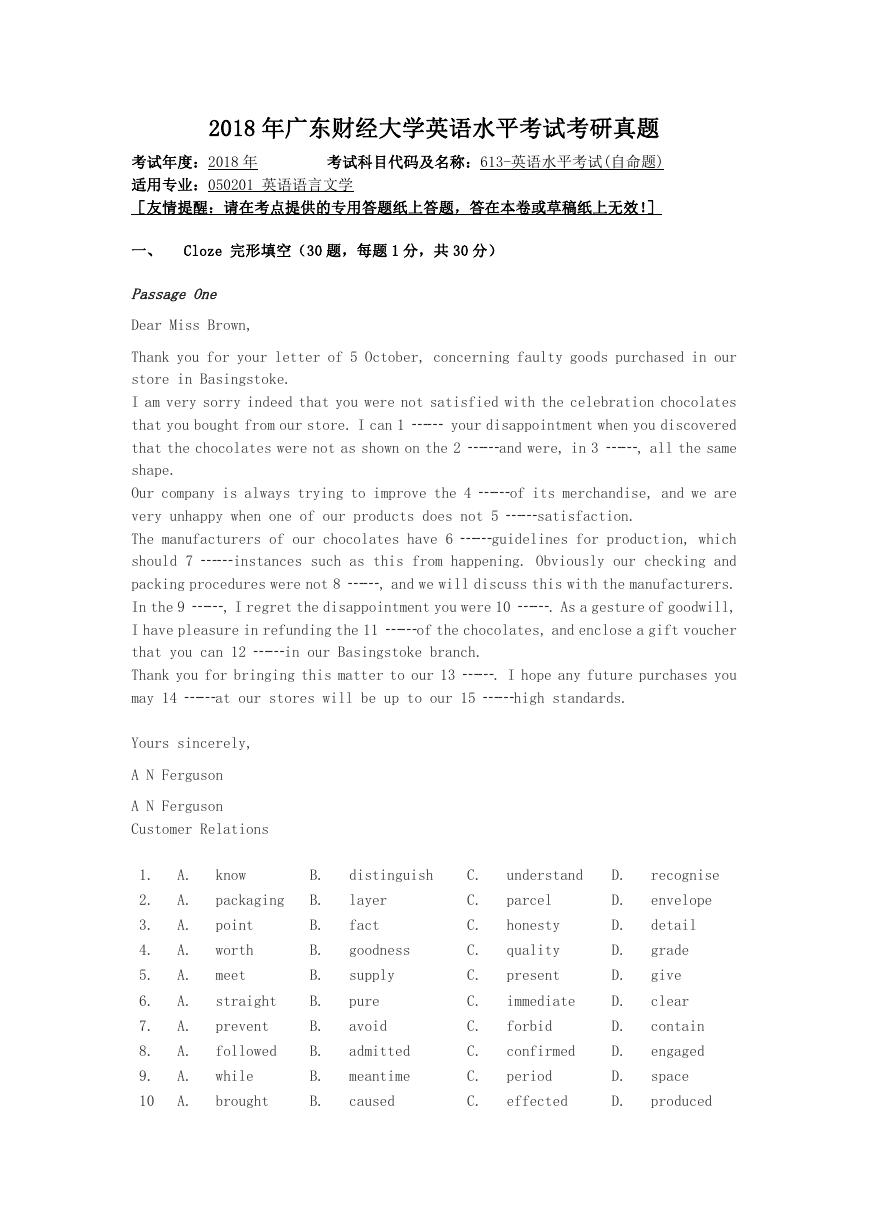
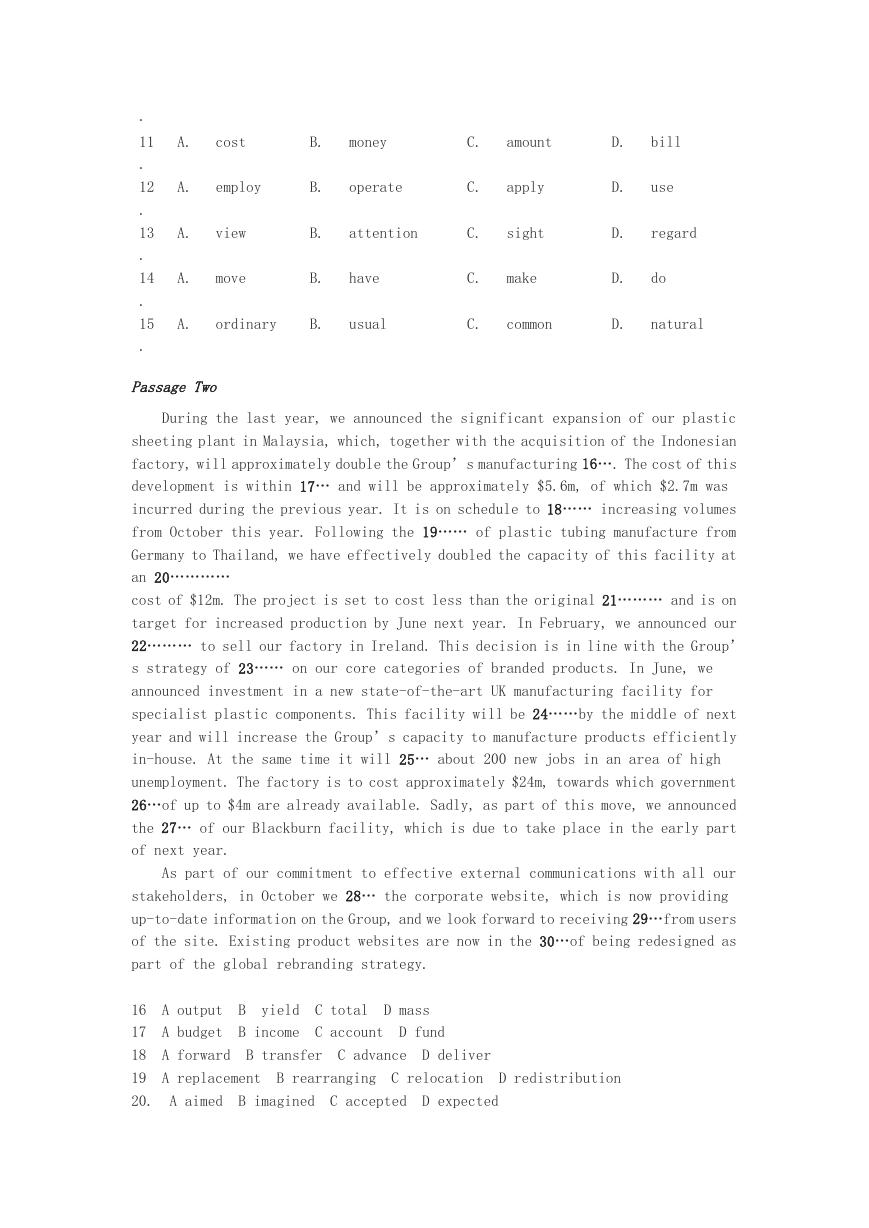
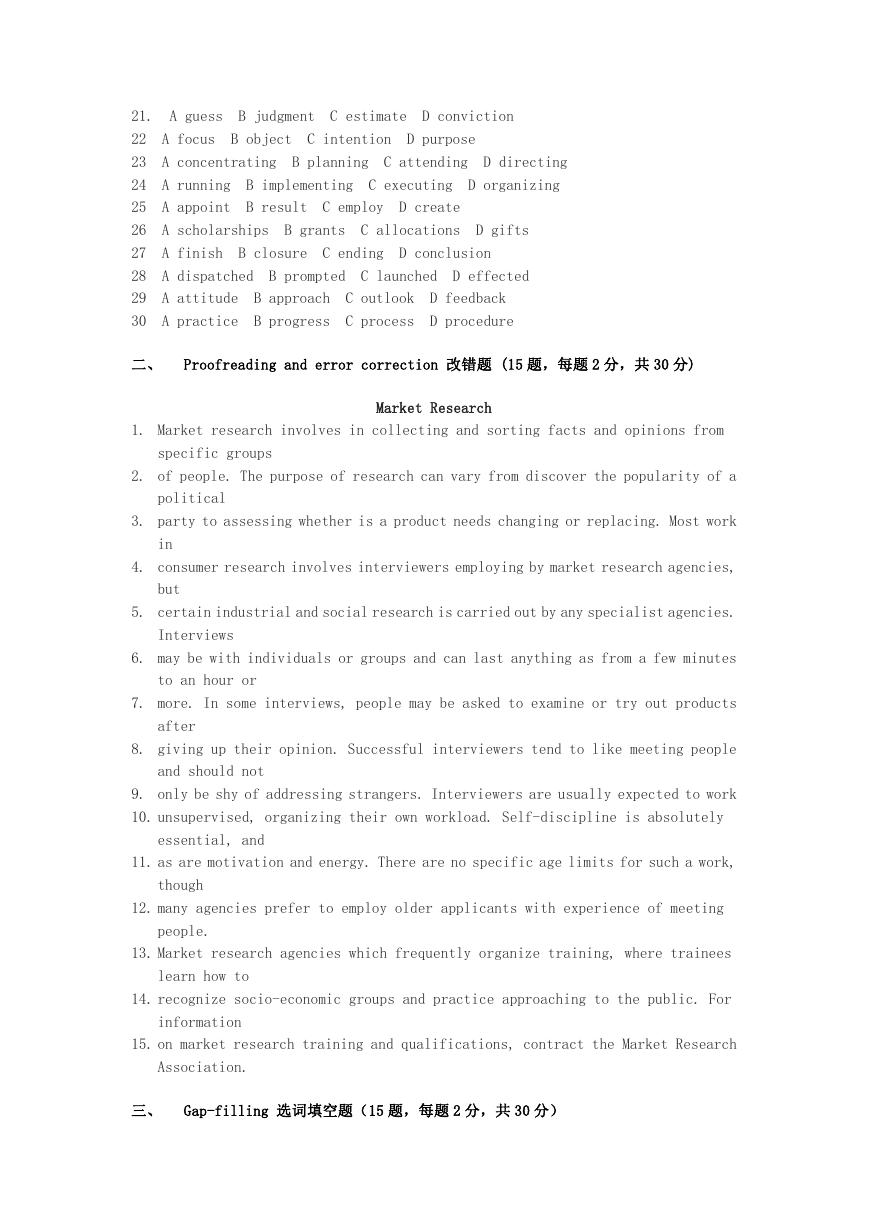
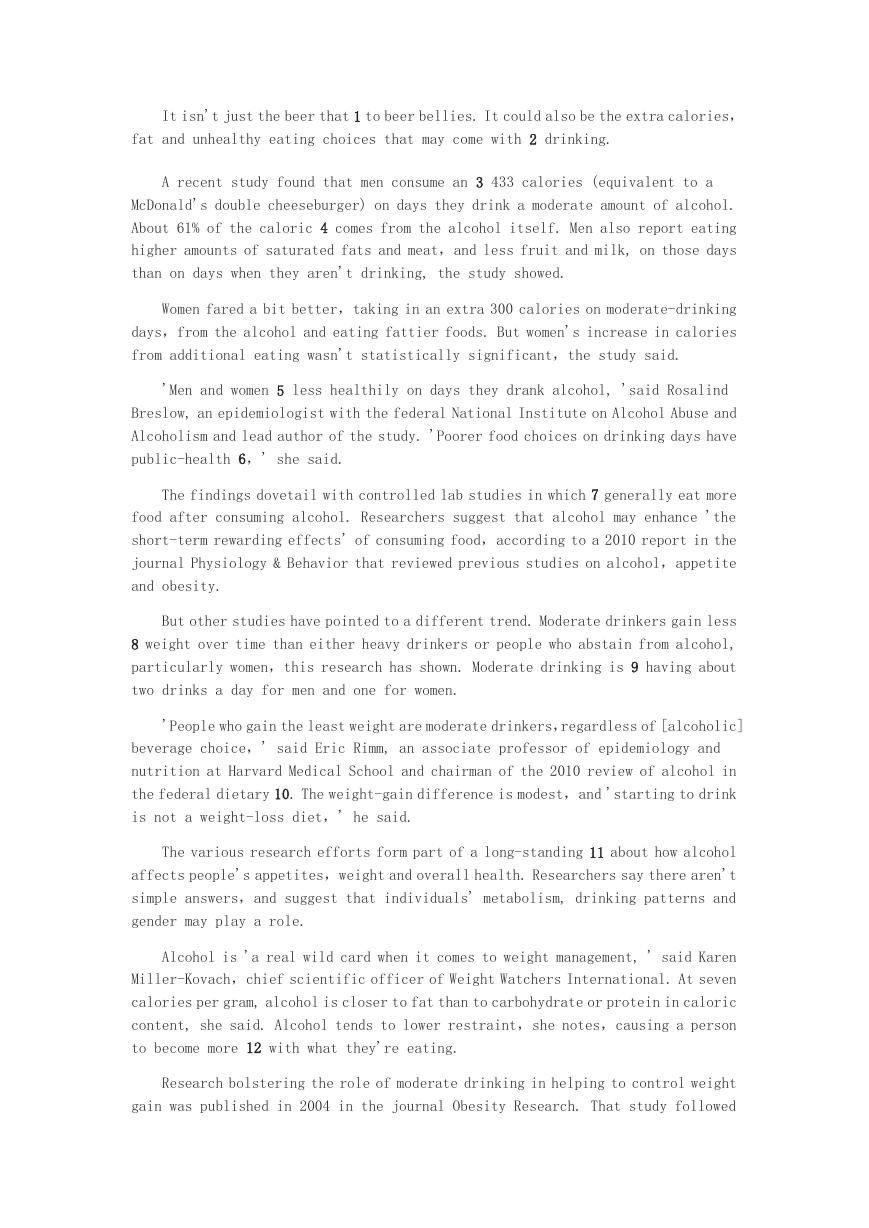
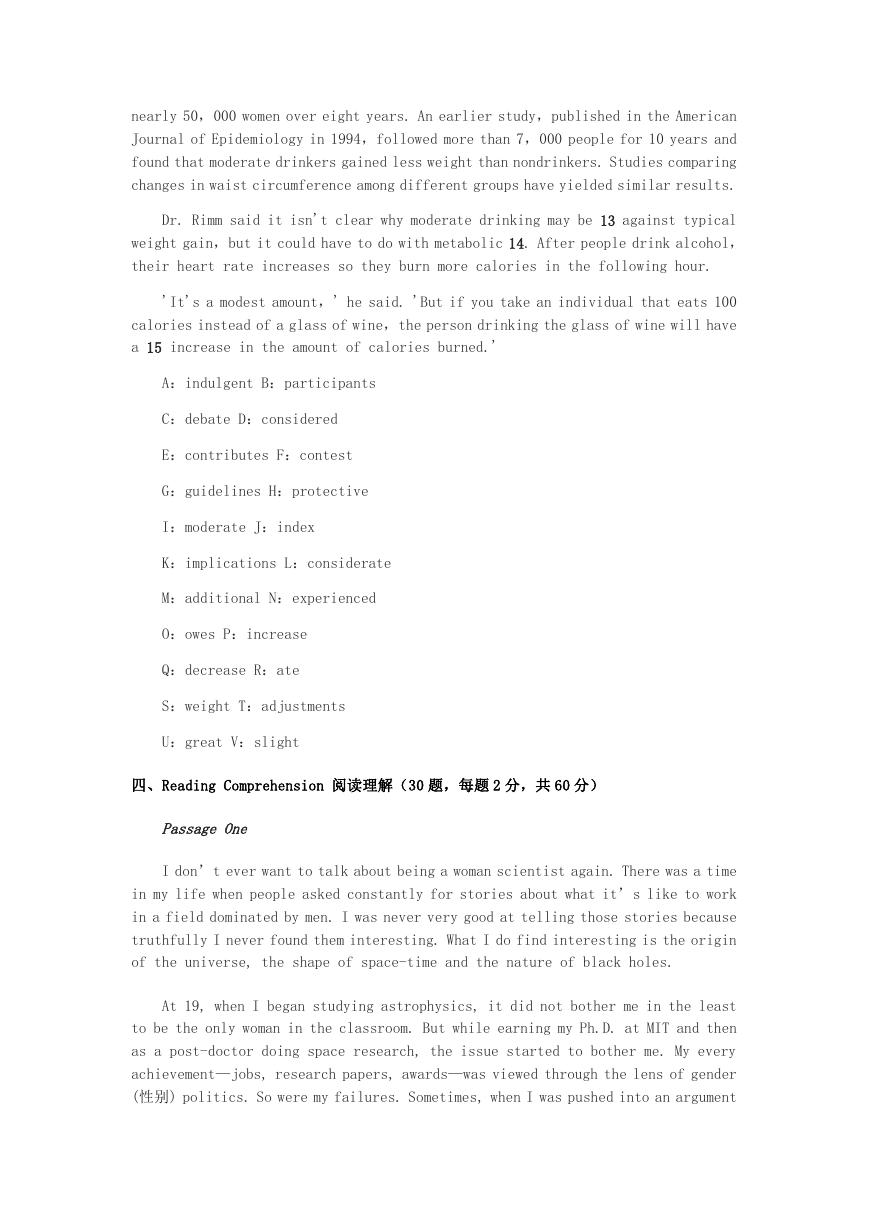
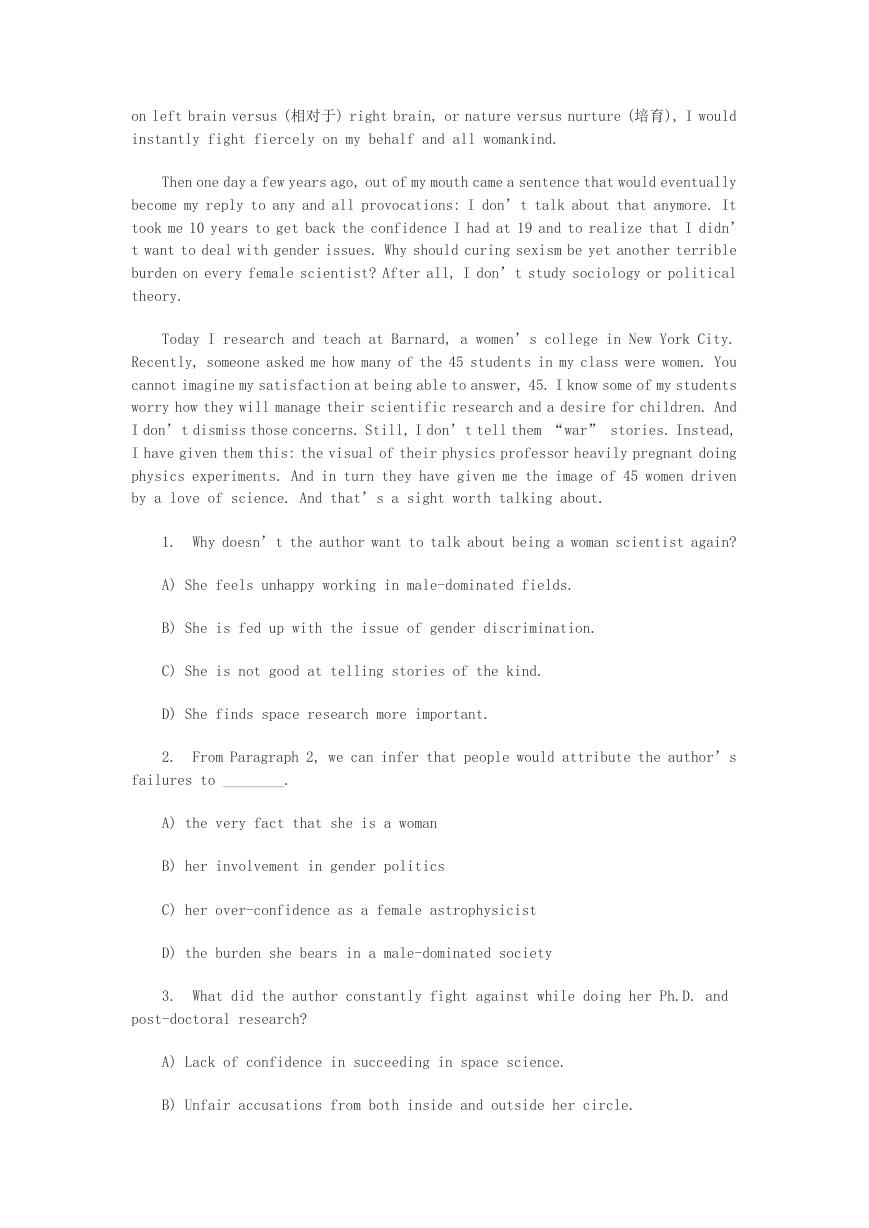
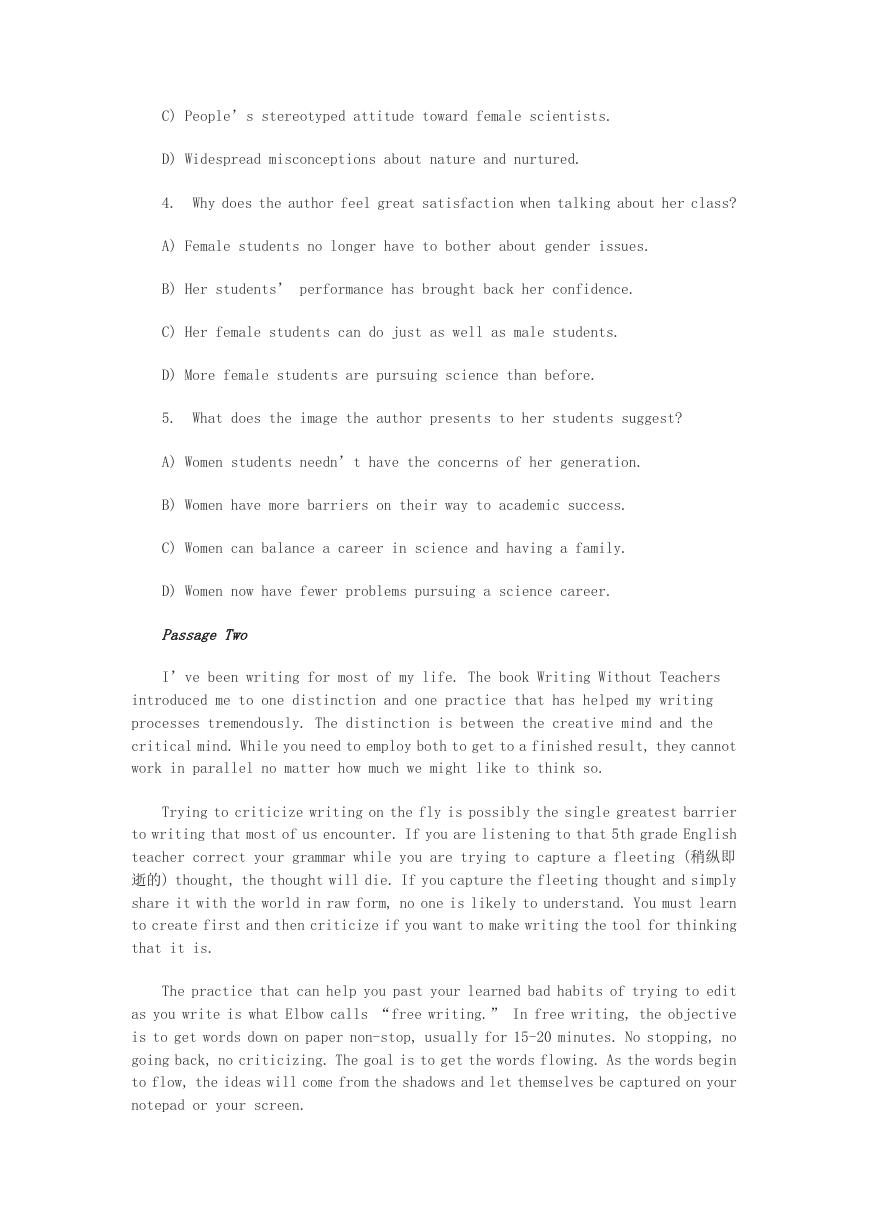
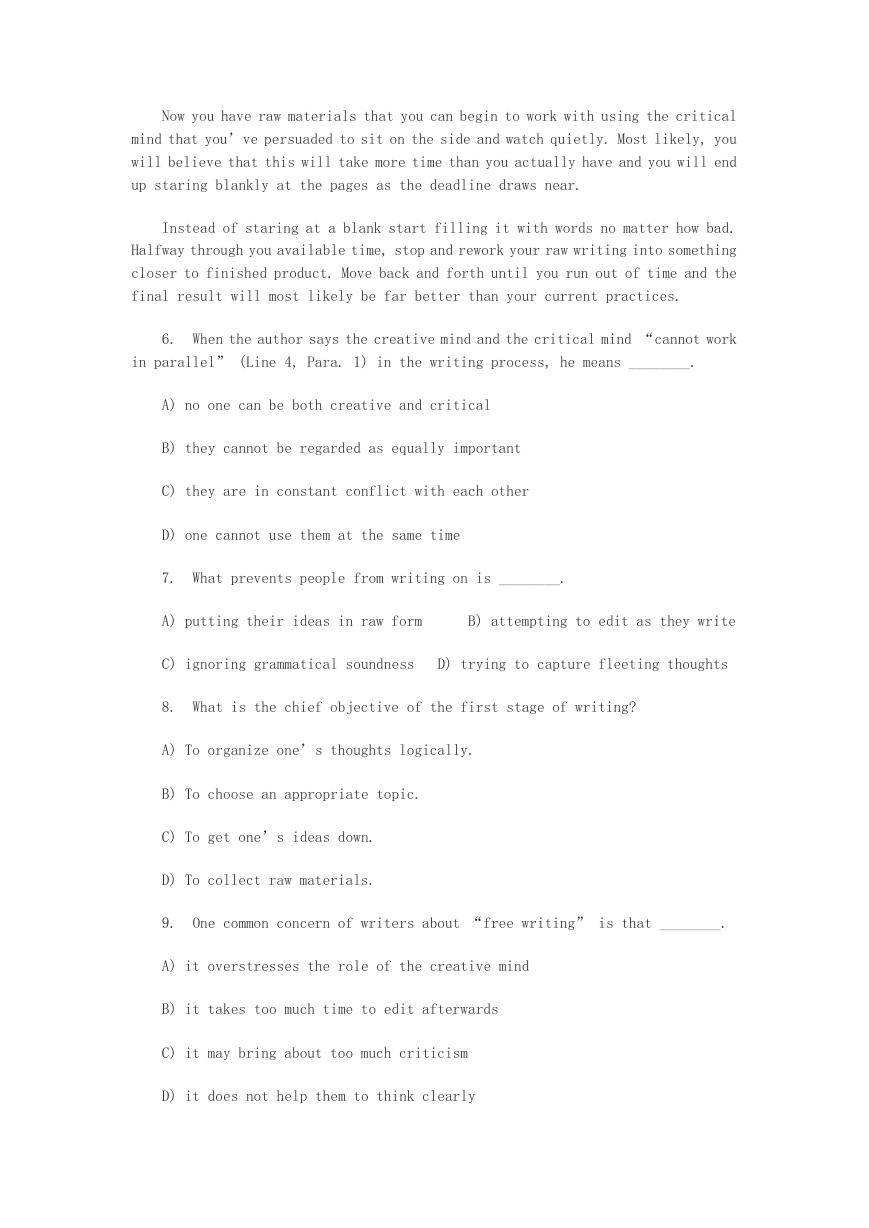








 2023年江西萍乡中考道德与法治真题及答案.doc
2023年江西萍乡中考道德与法治真题及答案.doc 2012年重庆南川中考生物真题及答案.doc
2012年重庆南川中考生物真题及答案.doc 2013年江西师范大学地理学综合及文艺理论基础考研真题.doc
2013年江西师范大学地理学综合及文艺理论基础考研真题.doc 2020年四川甘孜小升初语文真题及答案I卷.doc
2020年四川甘孜小升初语文真题及答案I卷.doc 2020年注册岩土工程师专业基础考试真题及答案.doc
2020年注册岩土工程师专业基础考试真题及答案.doc 2023-2024学年福建省厦门市九年级上学期数学月考试题及答案.doc
2023-2024学年福建省厦门市九年级上学期数学月考试题及答案.doc 2021-2022学年辽宁省沈阳市大东区九年级上学期语文期末试题及答案.doc
2021-2022学年辽宁省沈阳市大东区九年级上学期语文期末试题及答案.doc 2022-2023学年北京东城区初三第一学期物理期末试卷及答案.doc
2022-2023学年北京东城区初三第一学期物理期末试卷及答案.doc 2018上半年江西教师资格初中地理学科知识与教学能力真题及答案.doc
2018上半年江西教师资格初中地理学科知识与教学能力真题及答案.doc 2012年河北国家公务员申论考试真题及答案-省级.doc
2012年河北国家公务员申论考试真题及答案-省级.doc 2020-2021学年江苏省扬州市江都区邵樊片九年级上学期数学第一次质量检测试题及答案.doc
2020-2021学年江苏省扬州市江都区邵樊片九年级上学期数学第一次质量检测试题及答案.doc 2022下半年黑龙江教师资格证中学综合素质真题及答案.doc
2022下半年黑龙江教师资格证中学综合素质真题及答案.doc